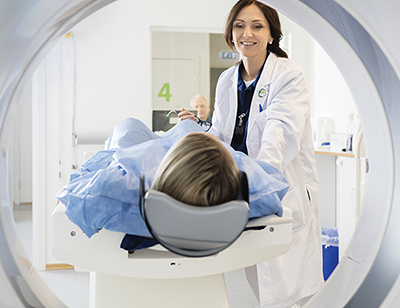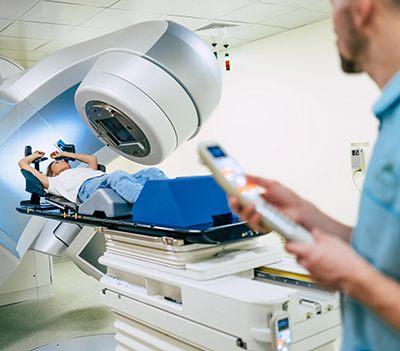
Who Should Wear a Dosimeter – And Why
As all RSOs know, there are known health risks involved with increased radiation exposure. From small practices with a handful of staff to extensive facilities with thousands of workers, RSOs do their utmost to ensure radiation staff is protected from the effects of ionizing radiation. A major component of that protection is determining who should wear a dosimeter every time radiation equipment is used to monitor and measure doses carefully, ensuring the highest possible safety protocols for staff. Even staff who aren't exposed directly to radiation should have a base awareness of the fundamental health risks and need to understand the basic ALARA principles of radiation safety.
| ALARA Safety Principles | |
|---|---|
| TIME | Use the shortest exposure time possible and closely watch the time. |
| DISTANCE | Radiation protection tools like dosimeters, help maintain the safest distances while still taking care of the patient. |
| SHIELDING | Wearing personal protection equipment (PPE) plus using advanced dosimeter technology to monitor exposure and radiation levels to prevent high dose rates |
Who Should Wear a Dosimeter?
 When determining who should wear a dosimeter, there is always some uncertainty about acceptable radiation levels with different equipment and direct patient involvement. Calculating the risk of exposure depends on several factors, including determining what equipment is used, by whom, how often, and where (e.g., standing close to the patient or in a control booth). Regularly referencing state regulations and accrediting bodies' standards help those managing a radiation protection program stay compliant.
When determining who should wear a dosimeter, there is always some uncertainty about acceptable radiation levels with different equipment and direct patient involvement. Calculating the risk of exposure depends on several factors, including determining what equipment is used, by whom, how often, and where (e.g., standing close to the patient or in a control booth). Regularly referencing state regulations and accrediting bodies' standards help those managing a radiation protection program stay compliant.
While more and more sophisticated medical imaging devices are developed, there have been parallel improvements in operator equipment that offer better shielding, remote operation, advancements in personal protective equipment (PPE), and dose reduction technology. Plus, state regulatory boards and accrediting organizations have deeper data to establish thresholds for radiation exposure. For example, while the national annual threshold is five mrem for deep tissue and 50 mrem for extremities, states may require quarterly monitoring, which could lead to overexposure if it exceeds a quarter of the annual accepted threshold. However, it is critical to note that there are no stated safe levels of exposure.
Why Should Dosimeters Be Worn?
Beyond the very obvious benefits of wearing dosimeters to monitor radiation dosage, Radiation Safety Officers (RSOs) can protect their facility from potential litigation by tracking dosimeter results and adhering to industry safety standards.
RSOs are wise to err on the side of strict monitoring, insisting on staff wearing dosimeters, and adherence to state and national guidelines. For example, suppose a staff member develops a medical condition (e.g., cancer) and decides to seek compensation for costs and claims negligence/overexposure on the part of the facility. Without the trackable and historical data provided by the dosimeters, the RSO will have difficulty proving compliance and defending the facility against the claim.
 Many jobs have daily radiation exposure, which is a necessary part of their role. Some of these jobs include radiologists, radiation oncologists, radiation technologists, nuclear medicine pharmacists, nuclear technologists and mammogram technicians, X-Ray technicians, CT/MRI technicians, and more. Different imaging devices, volume changes, rotating staff, specific modalities (dentists, veterinarians, industrial), etc., all mean fluctuating ionizing radiation exposure levels. Therefore, it becomes even more important to follow the state and accrediting bodies' regulatory guidelines regarding acceptable radiation levels and closely monitor staff by providing dosimeters.
Many jobs have daily radiation exposure, which is a necessary part of their role. Some of these jobs include radiologists, radiation oncologists, radiation technologists, nuclear medicine pharmacists, nuclear technologists and mammogram technicians, X-Ray technicians, CT/MRI technicians, and more. Different imaging devices, volume changes, rotating staff, specific modalities (dentists, veterinarians, industrial), etc., all mean fluctuating ionizing radiation exposure levels. Therefore, it becomes even more important to follow the state and accrediting bodies' regulatory guidelines regarding acceptable radiation levels and closely monitor staff by providing dosimeters.
5 Steps to Managing Exposure
What is the best plan for managing radiation exposure in your facility? There are some essential steps a radiation risk team can take to ensure compliance with state and national standards.
- Dosimeters are inexpensive, and RSOs must consider the big picture
- Dosimeter records provide critical documentation needed in case of litigation
- If any staff member is concerned about radiation, even with limited exposure, they should be provided with a dosimeter for a timeframe of at least 6 months to a year to provide historical data for reference
- State inspectors and accrediting organization surveyors will review who and who is not monitored, and RSOs need to be prepared to defend those decisions
- Perform risk analysis regularly and assess what changes have occurred, determine if exposure is higher or lower than expected, and consider using area dosimeters (in control rooms or surgical theaters) as well as personal dosimeters
